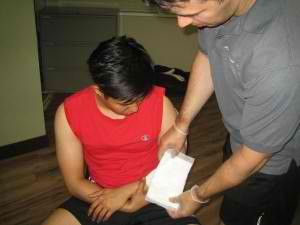Any type of injury on the skin is considered as a wound. They can be classified as open and closed. Open wounds are usually the ones that make the skin torn or broken. Closed wounds, on the other hand, have fewer categories, but they are just as injurious as open wounds; these include hematomas and crush injuries. Open wounds have five categories, incisions, lacerations, abrasions, contusions and punctured wounds.
Among these, the most commonly confused wounds are lacerations and incisions, because both of them make a cut to the skin. But the severity and intent of the cut is what makes the two different from each other. Let us take a look at how lacerations and incisions differ from each other.
What is a laceration?
Laceration is a type of wound that happens when the soft tissue in the body are torn. As a result, they are often jagged or irregular in size and shape. They are usually produced by some kind of blunt trauma to the skin. Because lacerations are produced by whatever object that caused the cut, the wound is usually contaminated with debris or bacteria.
What is an incision?

In comparison to laceration, an incised wound is caused by a sharp-edged object, such as a razor or a knife. This means that the size and shape of the wound are usually regular and the wound itself is smooth and neat unlike lacerations. Although incisions could happen as a result of a knife or glass shard accidents, they could also happen from purposeful opening of the skin, such as when a surgeon needs to perform open surgeries. This means that incised wounds can be both clean and contaminated, depending on the nature of the cut.
Which type of wound heals faster?
Incisions and lacerations both take some time to heal. But an incised wound heals faster than a lacerated wound. This is because lacerations are jagged, while incisions are regular in shape. Also, the smoothness and straightness of cuts in incisions produces fewer scars than a lacerated wound.
Additional note: remember to keep your wounds clean
Whether you have a laceration or incision, treating that cut is very important to avoid contamination, which could eventually lead to infection.
Always practice proper hand washing before cleaning the wound.
Keep in mind that wounds heal normally. Surgical wounds, however, may heal slower unless the wound dressings are changed regularly and the incision site is often checked for any contamination.
Check out this site for more standard first aid tips and techniques for bleeding wounds.
Related Video on Wound Cleaning:
Sources:
“Lacerations versus puncture wound.” Medline Plus. Retrieved online on July 30, 2014 from http://www.nlm.nih.gov/medlineplus/ency/imagepages/19616.htm
“Five Types of Wound.” LIVESTRONG.Com. Retrieved online on July 30, 2014 from http://www.livestrong.com/article/101274-five-types-wounds/
